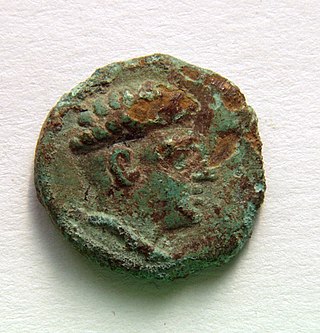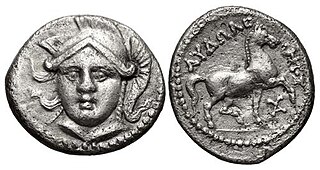
In antiquity, Paeonia or Paionia was the land and kingdom of the Paeonians or Paionians.
The Illyro-Roman Wars were a series of wars fought between the Roman Republic and the Illyrian kingdom under the Ardiaei and Labeatae. In the First Illyrian War, which lasted from 229 BC to 228 BC, Rome's concern was that the trade across the Adriatic Sea increased after the First Punic War at a time when Ardiaei power increased under queen Teuta. Attacks on trading vessels of Rome's Italic allies by Illyrian pirates and the death of a Roman envoy named Coruncanius on Teuta's orders, prompted the Roman senate to dispatch a Roman army under the command of the consuls Lucius Postumius Albinus and Gnaeus Fulvius Centumalus. Rome expelled Illyrian garrisons from a number of Greek cities including Epidamnus, Apollonia, Corcyra, Pharos and established a protectorate over these Greek towns. The Romans also set up Demetrius of Pharos as a power in Illyria to counterbalance the power of Teuta.
Taulantii or Taulantians were an Illyrian people that lived on the Adriatic coast of southern Illyria. They dominated at various times much of the plain between the rivers Drin (Drilon) and Vjosa (Aoös). Their central area was the hinterland of Epidamnos-Dyrrhachion, corresponding to present-day Tirana and the region between the valleys of Mat and Shkumbin (Genusus). The Taulantii are among the oldest attested Illyrian peoples, who established a powerful kingdom in southern Illyria. They are among the peoples who most marked Illyrian history, and thus found their place in the numerous works of historians in classical antiquity.

Gentius was an Illyrian king who belonged to the Labeatan dynasty. He ruled in 181–168 BC, being the last attested Illyrian king. He was the son of Pleuratus III, a king who kept positive relations with Rome. The capital city of the Illyrian kingdom under Gentius was Scodra.

Ballaios was an Illyrian king of the Ardiaei tribe. Attested only in coinage, Ballaios is considered as the predecessor of Agron. He is considered to have been a powerful and influential king as testified by the abundance of his silver and bronze coinage found along both coasts of the Adriatic. A hoard found in 2010 is one of the biggest hoards of ancient coins known, not only from Illyria. The capital of Ballaios' kingdom was Rhizon.
Rhizon was the capital of the Illyrian kingdom under the Ardiaei. During the Roman rule it was known as Rhizinium. Rhizon is the oldest settlement in the Bay of Kotor and the modern town of Risan stands near the old city.

Byllis or Bullis or Boullis (Βουλλίς) was an ancient city and the chief settlement of the Illyrian tribe of the Bylliones, traditionally located in southern Illyria. In Hellenistic times the city was either part of Illyria or Epirus. In Roman times it was included within Epirus Nova, in the province of Macedonia. The remains of Byllis are situated north-east of Vlorë, 25 kilometers from the sea in Hekal, Fier County, Albania. Byllis was designated as an archaeological park on 7 April 2003 by the government of Albania.
The Ardiaei were an Illyrian people who resided in the territory of present-day Albania, Kosovo, Montenegro, Bosnia and Herzegovina, and Croatia between the Adriatic coast on the south, Konjic on the north, along the Neretva river and its right bank on the west, and extending to Lake Shkodra to the southeast. From the 3rd century BC to 168 BC the capital cities of the Ardiaean State were Rhizon and Scodra.

Monounios or Monunius was an Illyrian king who reigned in southern Illyria, in the territory of the Taulantii, around the hinterland of Dyrrhachion and Apollonia. He is the first known Illyrian king to have struck his own silver coins, which were minted in Dyrrhachion. The fact that Monounios' coins were struck in the city mint of Dyrrhachion stresses that he exercised to some extent his authority over the city, as did his successor and probably son Mytilos later.
Damastion was an ancient city in the area of central Balkans, known for its silver coins dating back to the 4th century BC. It is attested only in Strabo who says that the city had silver-mines and locates it in Illyria. The ancient author reports that the city was under the authority of the Illyrian tribes of Dyestes and Enchelei-Sesarethii, and that Aegina colonized it. At 356–358 B.C. the mines came under the control of Macedon.
Mytilos or Mytilus was an Illyrian king who reigned in southern Illyria, around the hinterland of Dyrrhachion and Apollonia. He was the successor of Monunios, and probably his son. Mytilus is mentioned by Pompeius Trogus and Frontinus reporting the events of the military conflict between the Illyrians and the Epirotes under Alexander II, son of Pyrrhus. From around 270 BC Mytilus minted in Dyrrhachion his own bronze coins bearing the king's name and the symbol of the city.

The Bylliones were an Illyrian tribe that lived near the Adriatic coast of southern Illyria, on the lower valley of the Vjosa river, in the hinterland of Apollonia. The Bylliones were firstly attested in epigraphic material from the oracle of Dodona dating back to the 4th century BC, and their koinon was firstly attested in a 3rd-century BC inscription from the same oracle. Their territory was trapezoidal on the right side of the rivers Luftinje and Vjosa, extending in the west to the Mallakastra mountains. The chief city of their koinon was Byllis. Another important centre of their koinon was Klos, an earlier Illyrian settlement later called Nikaia, as an inscription attests. The Bylliones also inhabited in the area of an ancient sanctuary of the eternal fire called Nymphaion.

The Illyrian Kingdom was an Illyrian political entity that existed on the western part of the Balkan Peninsula in ancient times. Regardless of the number of the alternately ruling dynasties, of their tribal affiliation, and of the actual extension of their kingdom, it represented an alliance of Illyrian tribes that united under the rulership of a single leader, expressly referred to as "King of the Illyrians" in ancient historical records. The monarchic superstructure of the Illyrian state coexisted with the Illyrian tribal communities and the republican system of the Illyrian koina.
The history of the Illyrians spans from the beginning of the 2nd millennium BC up to the 1st century AD in the region of Illyria and in southern Italy where the Iapygian civilization flourished.

Patraus was king of the ancient kingdom of Paeonia from around 335 until his death in 315 BC. Patraus' relationship with the previous Paeonian king, Lyppeius, is unknown, as are the circumstances surrounding his ascension. Aside from the silver coinage struck in his name, we know nothing for certain about the events of Patraus' reign.

Audoleon was king of the ancient kingdom of Paeonia from 315 until his death in 285 or 284 BC. He succeeded his father, Patraus, under unknown circumstances.

The Labeatae, Labeatai or Labeates were an Illyrian people that lived on the Adriatic coast of southern Illyria, between modern Albania and Montenegro, around Lake Scodra.

Illyrian weaponry played an important role in the makeup of Illyrian armies and in conflicts involving the Illyrians. Of all the ancients sources the most important and abundant writings are those of Ennius, a Roman poet of Messapian origin. Weapons of all sorts were also placed intact in the graves of Illyrian warriors and provide a detailed picture for archaeologists on the distribution and development of Illyrian weaponry.
The Illyrians were a group of Indo-European speaking peoples, who inhabited the western Balkan Peninsula in ancient times. They constituted one of the three main Paleo-Balkan populations, along with the Thracians and Greeks.
















